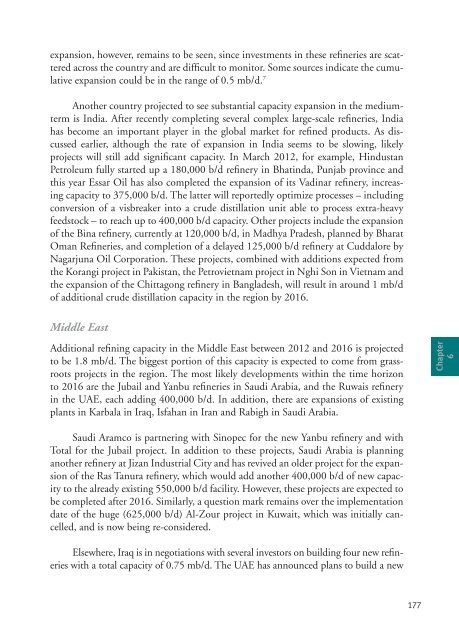World Oil Outlook - Opec
World Oil Outlook - Opec
World Oil Outlook - Opec
- TAGS
- world
- outlook
- opec
- www.opec.org
Create successful ePaper yourself
Turn your PDF publications into a flip-book with our unique Google optimized e-Paper software.
expansion, however, remains to be seen, since investments in these refineries are scattered<br />
across the country and are difficult to monitor. Some sources indicate the cumulative<br />
expansion could be in the range of 0.5 mb/d. 7<br />
Another country projected to see substantial capacity expansion in the mediumterm<br />
is India. After recently completing several complex large-scale refineries, India<br />
has become an important player in the global market for refined products. As discussed<br />
earlier, although the rate of expansion in India seems to be slowing, likely<br />
projects will still add significant capacity. In March 2012, for example, Hindustan<br />
Petroleum fully started up a 180,000 b/d refinery in Bhatinda, Punjab province and<br />
this year Essar <strong>Oil</strong> has also completed the expansion of its Vadinar refinery, increasing<br />
capacity to 375,000 b/d. The latter will reportedly optimize processes – including<br />
conversion of a visbreaker into a crude distillation unit able to process extra-heavy<br />
feedstock – to reach up to 400,000 b/d capacity. Other projects include the expansion<br />
of the Bina refinery, currently at 120,000 b/d, in Madhya Pradesh, planned by Bharat<br />
Oman Refineries, and completion of a delayed 125,000 b/d refinery at Cuddalore by<br />
Nagarjuna <strong>Oil</strong> Corporation. These projects, combined with additions expected from<br />
the Korangi project in Pakistan, the Petrovietnam project in Nghi Son in Vietnam and<br />
the expansion of the Chittagong refinery in Bangladesh, will result in around 1 mb/d<br />
of additional crude distillation capacity in the region by 2016.<br />
Middle East<br />
Additional refining capacity in the Middle East between 2012 and 2016 is projected<br />
to be 1.8 mb/d. The biggest portion of this capacity is expected to come from grassroots<br />
projects in the region. The most likely developments within the time horizon<br />
to 2016 are the Jubail and Yanbu refineries in Saudi Arabia, and the Ruwais refinery<br />
in the UAE, each adding 400,000 b/d. In addition, there are expansions of existing<br />
plants in Karbala in Iraq, Isfahan in Iran and Rabigh in Saudi Arabia.<br />
Saudi Aramco is partnering with Sinopec for the new Yanbu refinery and with<br />
Total for the Jubail project. In addition to these projects, Saudi Arabia is planning<br />
another refinery at Jizan Industrial City and has revived an older project for the expansion<br />
of the Ras Tanura refinery, which would add another 400,000 b/d of new capacity<br />
to the already existing 550,000 b/d facility. However, these projects are expected to<br />
be completed after 2016. Similarly, a question mark remains over the implementation<br />
date of the huge (625,000 b/d) Al-Zour project in Kuwait, which was initially cancelled,<br />
and is now being re-considered.<br />
Elsewhere, Iraq is in negotiations with several investors on building four new refineries<br />
with a total capacity of 0.75 mb/d. The UAE has announced plans to build a new<br />
177<br />
Chapter<br />
6
















